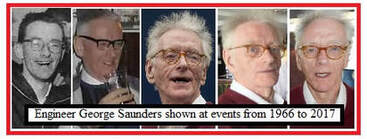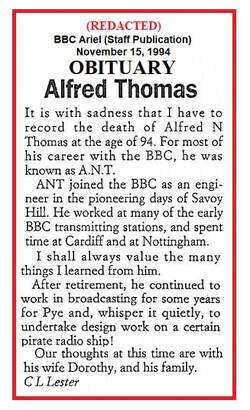|
Prince Charles explains 'pebble theatre'.
|
PEBBLE
|
|
Don Pierson [right] explains how a young Prince Charles made a request to join the Radio London fan club. |
|
|
Prince Charles explains 'pebble theatre'.
|
PEBBLE
|
|
Don Pierson [right] explains how a young Prince Charles made a request to join the Radio London fan club. |
|
 In yesterday's blog, we got to the point in George Saunders' storyline where he had just arrived at Greenore. He came in a car which John Gilman appears to have been driving, since George does not mention any additional occupant. "When we parked the car", said George, "I saw two ships, one looked like a ship and it was large." The larger vessel was the mv Caroline; ex-Iseult; ex-Fredericia. It had departed under tow from Rotterdam, Holland on February 13, 1964 and was then brought to a disused wharf at Greenore, Eire. As they walked past the ship, Gilman remarked "Oh that’s not ours” and then they arrived at a smaller ship that George thought looked like a coaster. This was the mv Mi Amigo; ex-Magda Maria; ex-Bon Jour which had arrived at Greenore under its own power on March 13, 1964. The ship remained at Greenore until April 17, 1964, for a total of 35 days. Therefore, even though George Saunders did not provide an exact date for his visit, we know that it was after Friday, March 13, since the ship was already there, and before Tuesday, March 23, 1964 when the mv Caroline departed from Greenore which provides a maximum window of 11 days. But since the mv Caroline was not getting ready to depart, it was during a much narrower window of time more akin to the week beginning on Sunday, March 15, 1964, and ending on Saturday, March 20, 1964. Therefore it is also possible that George Saunders had not as yet burned his bridge to Marconi, and that he undertook this visit on the weekend of Saturday-Sunday March 14-15, 1964. The reason for reaching that conclusion is because when Gilman and Saunders boarded the mv Mi Amigo and went below top deck, they met another man who caused George to react in obvious deference. This was all due to this man's immediate appearance. George figuratively bowed to the apparent superior authority of this man and then immediately began addressing him as "Sir". According to George, this man seemed to like George's manifestations of outward subservience, but then he began to grill George about his knowledge of broadcasting transmitters and radio engineering. George felt under pressure and that he was being given a verbal examination if he wanted the job. It was under this stress point that his interrogator suddenly turned to Gilman and said: "Right you'll do", meaning George Saunders, and not Gilman. If George had failed this test, which to this day he still rates as one of the more grueling impromptu technical examinations that he has ever had to take, then it is possible that he could have returned to his boring assignment at Marconi the following Monday to resume work on a marine radar handbook. In fact, this is the more likely scenario since George Saunders did not remain at Greenore to sail with the mv Mi Amigo when the ship departed on Friday, April 17, 1964. After George passed his aural examination and being told "Right you'll do", George later recounted: "So I said 'Okay', I was duly inducted." George then added: "A couple of days later, I was joined by another chap, the name fails me, I can see the face, gosh a chap called Grays no the name’s gone but he joined about two days after me and under John Gilman’s guidance, we did various things to getting it all set up." Whether George arrived on Friday March 13, 1964, or whether he stayed on for a few days longer on leave from Marconi, is not clear, but it is clear that he did not stay at Greenore and leave with the Mi Amigo. However, we also have another clue about the time frame as a result of George's additional comments during the same OEM interview about his time at Greenore when he was told: ".... we need quite a bit of work doing yet, it’s not ready to go. This ship has been on the air previously but the aerial has to be rigged." So clearly Harry Spencer who rigged the antenna had not as yet completed his work. While some may think that this concentration on the specificity of dates is tedious and totally unnecessary, the fact is that by skipping lightly over timelines, the vast majority of writers who have addressed the subject of offshore radio, have created fables out of thin air in order to connect dots that do not exist! But after passing his "aural exam", George was then invited to look around the Mi Amigo where everything below top deck was being lit by local power. They went down into the hold and looked at the two 10kW Continental Electronics transmitters, after which, they then moved on to inspect the studio and its gear. George Saunders continued: "Now we come back to the chap I mentioned earlier on, the chap who gave me the rigorous interview - now this chap was A. N. Thomas, and he had been chief engineer transmitters BBC, so that’s why I got such a heavy interview. And he had also been head of planning and insulation department as well."  George Saunders sent us an obituary notice from the BBC staff magazine, and it seems that until it was pointed out to George Saunders, he was unaware that it was general knowledge that Alfred Nicholas Thomas had retired from the BBC and taken up employment with Charles Orr Stanley and his Pye Group of Companies. In some quarters, it was also common knowledge that Alfred Nicholas Thomas who was employed by the BBC at the time, not only knew of, but that he worked with Arthur Carrington of Marconi on a major project. But the dots connecting Thomas with Carrington, also connected both Thomas and Carrington with Pye, In addition to these connections, Thomas also became involved with fellow BBC retiree John Howard Gilman. Their connecting dots go from the BBC to Pye and a Pye assignment at Radio Veronica. Then their scene shifted to Swanson's GBOK alongside the Pye facility at Sheerness. Sensing the desperate mess that Allan James Crawford had repeatedly got himself into by trying to start an offshore radio station to promote his own music business, John Stanley, son of Charles Orr Stanley and head of the Pye Group of companies, then stepped in to take charge. This how and why Thomas and Gilman entered into the life of Allan James Crawford. However, what the average reader saw on their printed pages of the daily newspapers, was a collection of meaningless stories about Ronan O'Rahilly, and Crawford was under strict instructions to keep his mouth shut while two public relations firms got to work to spread misinformation. The real story behind this 'Electrical installation dispute' which unravels a lot of behind-the-scenes details that have been distorted or skipped-over by others, will be continued here in part 7, tomorrow. Comments are closed.
|
Our team produced this free radio program for PCRL in Birmingham.
It was repeatedly broadcast on and after October 20, 1985. Click & listen! Blog Archive
August 2023
Copyright 2021 with all rights reserved.
|
Index |
Library |
|
